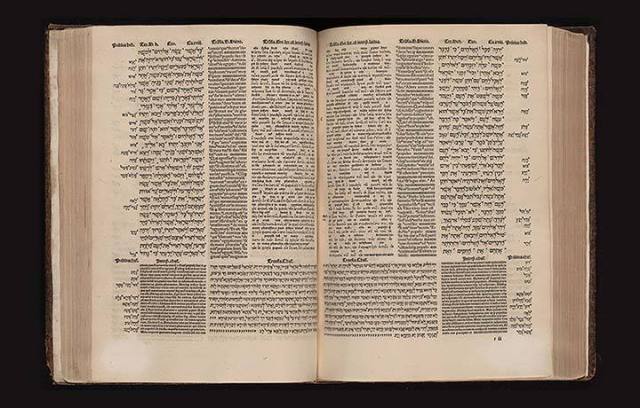This year marks the 500th anniversary of the first printed Greek New Testament (January 10, 1514). While the honor for the first published Greek New Testament is rightly awarded to Erasmus’ 1516 edition, the first GNT was actually printed a year before that. Erasmus learned of the recent printing of this title, and so rushed to get his edition of the GNT to the publisher so as to be the first. While he did succeed, because of the rush his first edition is often considered to have the most errors of any volume ever published!
The full title of this rival to Erasmus was Novum Testamentum Graece et Latine in Academia Complutensi Nouiter Impressum. It was part of a “polyglot” edition of the Bible, which means the text appeared in several different languages. This polyglot became known as the Complutensian Polyglot.
Contents
Published in six volumes, the Complutensian was the first of its kind. Volumes 1–4 contain the Old Testament in 3 parallel columns: Hebrew, the Latin Vulgate, and the Greek Septuagint. The Pentateuch also contained columns for the Aramaic text and its own Latin translation. The Greek New Testament was included in its fifth volume, and consisted of the GNT and the Vulgate in parallel columns. The first Greek dictionary, along with various other study aids, composed volume six.
So What?
A work of this import and magnitude should not be overlooked. With the development of the printing press, the Bible could be much more accurately copied and widely distributed. It was commissioned by the cardinal primate of Spain, Francisco Ximenes de Cisneros.It was the first printed polyglot of the entire Bible, and thus contained the first printed edition of the Greek New Testament. It also contained the first Greek glossary of the New Testament, which would then be followed by countless others. Cardinal Francisco’s reason for embarking on this project is worth quoting:
“… the most learned translator can present only a part of this, the full Scripture in translation inevitably remains up to the present time laden with a variety of sublime truths which cannot be understood from any source other than the original language. Moreover, wherever there is diversity in the Latin manuscripts or the suspicion of a corrupted reading (we know how frequently this occurs because of the ignorance and negligence of copyists), it is necessary to go back to the original source of Scripture … to examine the authenticity of the books of the Old Testament in the light of the correctness of the Hebrew text and of the New Testament in the light of the Greek copies. And so that every student of Holy Scripture might have at hand the original texts themselves and be able to quench his thirst at the very fountainhead of the water that flows unto life everlasting and not have to content himself with rivulets alone, we ordered the original languages of Holy Scripture with their translations adjoined to be printed.”
His desire was to “to revive the languishing study of the ancient Scriptures.”
This is indeed a worthy goal, and a need that has not waned. We do not read the Bible in a vacuum, but we are indepted to those who have through much hard and diligent work completed tremendous tasks from which we reap the benefits. The Complutensian Polyglot is most certainly one that deserves to be recognized among them.
Related articles
- What is Textual Criticism and Why It Matters: Intro (mattmcmains82.wordpress.com)
- What is the Latin Vulgate Bible? (altruistico.wordpress.com)
- Novum Instrumentum Omne (theriune.wordpress.com)
- The 500th Anniversary of the Complutensian Polyglot New Testament (friendsofcsntm.com)


Matt,
Thank you for this brief but interesting article on the Polyglot of Ximines. I added a link to your article on my blog where I referred to this very interesting publication. My best wishes for your studies. And thank you for the beautiful photo of your family on your “about me” page.
God bless,
Herman Grobler, Pretoria, South Africa.
I wonder how many people can actually read Koine Greek, a language Jesus did not speak, and for all intensive purposes, was nothing more than a pagan language.